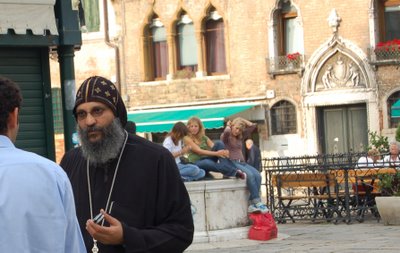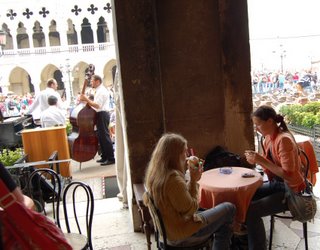Patterns in a picture IV

More patterns, and the physics of Venice's effect upon people.
1. Possibility : Anything that is truly good, is possible.
Unfortunately, we rarely believe it's achievable. Usually, the behavior of other people prevented us, from when we were small, from realizing our most pleasant dreams. Maybe your village was bombed; maybe your parents told you to stop playing; maybe you feel hurt by friends; maybe teachers, bosses and mass media coerced you, or bribed you, into conformist thinking.
One way or another, if someone proposes something fantastic, not physically impossible, but simply too wonderful & difficult, we're likely to dismiss it, and say "that will never happen".
In the face of that, Venice stands. Seemingly impossible; and yet impossibly successful. Successful because it followed a simple idea: "let's live in the middle of this lagoon." It overcame the difficulties of that proposal. Its existence, and our ability to touch it, immediately gives us hope of a better world. It makes us forget bad things ... war, debts, jealousy, greed, hate ... things that have been as much a part of life here as anywhere else. But here, somehow, the normal problems of the world did not defeat an improbable, positive, massive project.
That's something to take home with you. Don't give up on a beautiful idea.
2. We are water : and water is life. When we have ideas, when we solve problems, when good things happen, when they are harmonious, we are "going with the flow". We are more "fluid". And nothing else, for some reason, can "get our juices flowing" the way that water can, and the more integrated our lives are with water, the better. No land-bound town survives without its river, its aquifers, its wells, its springs, its swales, its irrigation systems, its waterfalls, its seafront, its lakefront ... water keeps us alive, not just technically. Without being part of a natural cycle of water, of rain and evaporation, of storm and calm, it is impossible to even feel alive, let alone make the world around us more alive.
If Venice offers us any single prescription for achieving our dreams -- for fulfilling life's great possibilities -- it is this: get as close as you can to the source of life. Get in touch with water. Hold on to it, integrate it with everything in your daily life, at every scale imaginable. Take care of it, respect it, and it will feed your souls, it will continually revive your community, and anything will become possible.








